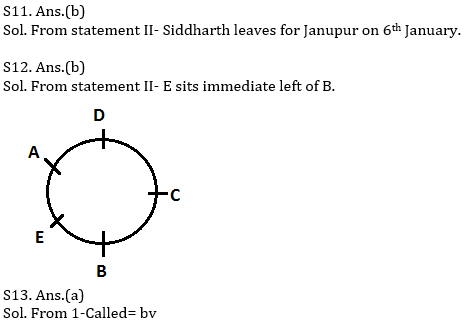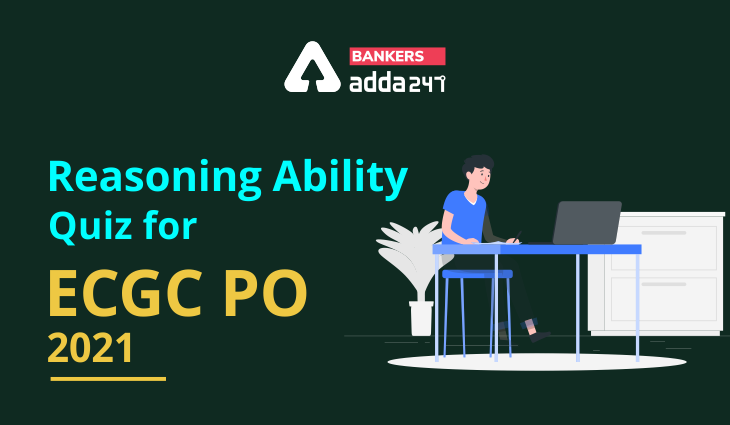Directions (1-5): Study the following information carefully and answer the given questions.
There are eight people A, B, C, D, E, F, G and H who are sitting around a circular table. Each of them belongs to different occupations viz. Doctor, Engineer, Bank manager, Chef, Architect, Painter, Musician and Dancer (not necessarily in the same order). Four of them are facing towards the center while others face outside the center.
G is fourth to the left of F. Neither G nor F is an immediate neighbor of D. A is a Dancer and sits third to the left of the one who is an Architect. C is a Bank manager and sits exactly between A and F. The one who is a Painter sits second to the right of the one who is a Bank manager. E sits third to the left of A. C is facing the center and is to the immediate right of both A and F. B and G faces the same directions. D is third to the right of H. The one who is Architect is on the immediate left of D, who is not a Musician. The one who is an Engineer sits second to the left of the one who is a Dancer. The one who is a Doctor sits second to the right of D.
Q1. Who among the following person is a Doctor?
(a) C
(b) G
(c) E
(d) B
(e) None of these
Q2. E belongs to which of the following occupations?
(a) Doctor
(b) Dancer
(c) Musician
(d) Bank manager
(e) None of these
Q3. The one who sits 2nd to left of B belongs to which occupation?
(a) Musician
(b) Painter
(c) Architect
(d) Chef
(e) None of these
Q4. Who among the following person is a Musician?
(a) B
(b) G
(c) D
(d) H
(e) None of these
Q5. Which of the following statement is incorrect?
(a) D faces outside
(b) G is an Engineer
(c) H faces outside
(d) F faces inside
(e) D is a Chef
Directions (6- 10): In the following questions, the symbols @, &, %, $ and # are used with the following meaning as illustrated below:
‘P @ Q’ means ‘P is not smaller than Q’
‘P &Q’ means ‘P is neither greater than nor equal to Q’
‘P# Q’ means ‘P is neither greater than nor smaller than Q’
‘P $ Q’ means ‘P is not greater than Q’
‘P % Q’ means ‘P is neither smaller than nor equal to Q’.
Now in each of the following questions assuming the given statements to be true, find which of the three conclusions follow and give answer accordingly.
Q6. Statement: A%B#C%D$E; G@F%B
Conclusion: I. G@A II. A&G
(a) if only conclusion II is true.
(b) if only conclusion I is true.
(c) if neither conclusion I nor II is true.
(d) if either conclusion I or II is true.
(e) if both conclusions I and II are true.
Q7. Statement: R%T@J%A$S#H; I%T
Conclusion: I. H#A II. H%A
(a) if both conclusion I and II are true.
(b) if only conclusion I is true.
(c) if neither conclusion I nor II is true.
(d) if either conclusion I or II is true.
(e) if only conclusion II is true.
Q8. Statement: C@A%R&P@W; A@N#T
Conclusion: I. T$C II. T&P
(a) if only conclusion II is true.
(b) if either conclusion I or II is true.
(c) if neither conclusion I nor II is true.
(d) if only conclusion I is true.
(e) if both conclusions I and II are true.
Q9. Statement: P%T#D$H@S; H%N; T#G; H&M
Conclusion: I.G&M II. P%G
(a) if only conclusion II is true.
(b) if only conclusion I is true.
(c) if neither conclusion I nor II is true.
(d) if either conclusion I or II is true.
(e) if both conclusions I and II are true.
Q10. Statement: N@V$R#M%I#K; F&M; V%C; R%D
Conclusion: I. N#C II. D%F
(a) if only conclusion II is true.
(b) if either conclusion I or II is true.
(c) if neither conclusion I nor II is true.
(d) if only conclusion I is true.
(e) if both conclusions I and II are true.
Directions (11-15): Each of the questions below consist of a question and two statements numbered I and II given below it. You have to decide whether the data provided in the statements are sufficient to answer the question. Read both the statements and give answer
(a) if the data in statement I alone are sufficient to answer the question, while the data in statement II alone are not sufficient to answer the question.
(b) if the data in statement II alone are sufficient to answer the question, while the data in statement I alone are not sufficient to answer the question.
(c) if the data either in statement I alone or in statement II alone are sufficient to answer the question.
(d) if the data in both statement I and II together are not sufficient to answer the question.
(e) if the data in both statement I and II together are necessary to answer the question.
Q11. On which date Siddharth leaves for Jaunpur in January month?
I. Siddharth takes leave for one week from his office in January month starting from 5th January.
II. Siddharth mother correctly remembers that Siddharth leaves for Jaunpur after 5th but before 7th January.
Q12. Five persons A, B, C, D and E are sitting around a circular table with all of them facing towards the center. Who sits immediate left of B?
I. A sits third to right of B. C sits third to right of A.
II. B sits immediate left of C who sits second to left of A. D does not sit adjacent to B.
Q13. What is code of “called”?
I. In certain language, “meeting had been called” is written as “ sx vt bv mp” and “ they called every time” is written as “ bv ct fa jl “ .
II. “you called every hour” is written as “ca bv jl ma”.
Q14. Point S is in which direction with respect to point Y?
I. Point S is in north of Point X. Point X is in east of Point T. Point T is in north of point V which is west of Point Y.
II. Point Y is west of Point X. Point X is in west of Point T which is north of V. Point V is east of Point S which is south of Point X.
Q15. Five persons A, B, C, D and E are of different weight. Who is heaviest?
I. B is heavier than C and D but lighter than E who is not the heaviest.
II. E is heavier than B and C but lighter than A.
Practice More Questions of Reasoning for Competitive Exams:
Reasoning for Competitive Exams |
Reasoning Ability Quiz For ECGC PO 2021- 14th February |
Reasoning Ability Quiz For ECGC PO 2021- 13th February |
ECGC PO Study Plan 2021 |
Solutions




Practice with Crash Course and Online Test Series for ECGC PO 2021:
- ECGC Online Coaching Classes for Probationary Officier 2021
- ECGC PO Mock Tests 2021 – Banking Online Test Series (With Solutions) by Adda247
- ECGC PO 2021 Complete eBooks Kit (English Medium)
Click Here to Register for Bank Exams 2020 Preparation Material




 GA Capsule for SBI Clerk Mains 2025, Dow...
GA Capsule for SBI Clerk Mains 2025, Dow...
 The Hindu Review October 2022: Download ...
The Hindu Review October 2022: Download ...
 SBI CBO Admit Card 2025 Out at sbi.co.in...
SBI CBO Admit Card 2025 Out at sbi.co.in...


